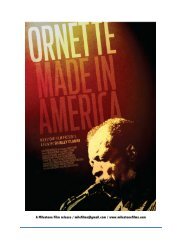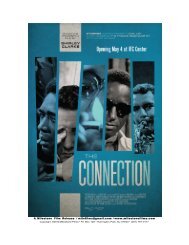ORNETTE Press Kit.8.7.2012 - Shirley Clarke
ORNETTE Press Kit.8.7.2012 - Shirley Clarke
ORNETTE Press Kit.8.7.2012 - Shirley Clarke
You also want an ePaper? Increase the reach of your titles
YUMPU automatically turns print PDFs into web optimized ePapers that Google loves.
addition to destroying his tenor saxophone. In the early 1950s, his experimentations were<br />
rarely appreciated and he lived without fanfare in Los Angeles.<br />
“Ornette Coleman has consistently been ahead of his time,” wrote Robert Palmer in the<br />
New York Times. “Mr. Coleman has been genuinely visionary.”<br />
Pat Metheny, who collaborated with Coleman on the 1986 album Song X, said Coleman is “a<br />
man who made his own music, his own way, with a body of work to show for it that stands<br />
as one of the great musical achievements of this era.”<br />
It was in 1958 that Coleman started attracting attention when he moved to New York City<br />
and began a series of performances that changed the history of jazz. Renowned jazz critic<br />
Martin Williams, in the October 1959 issue of Jazz Review, proclaimed, “I honestly believe …<br />
that what Ornette Coleman is doing on alto will affect the whole character of jazz music<br />
profoundly and pervasively.”<br />
His seminal 1959 album The Shape of Jazz to Come, with its activist title, stirred debate that<br />
has not settled even today — Ken Burns’ 2001 Jazz miniseries largely dismissed the whole<br />
avant-‐garde movement. Often, his acclaim was sometimes met with skepticism by<br />
traditional jazz enthusiasts. But with the support of established jazz figures like John<br />
Coltrane and Charles Mingus as well as appreciation from ‘serious’ composers like Leonard<br />
Bernstein and Gunther Schuller, Coleman weathered the backlash to his unorthodox style.<br />
It was with The Shape of Jazz to Come that the famous quartet of Coleman, trumpeter Don<br />
Cherry, bassist Charlie Haden and drummer Billy Higgins struck the first notes of a jazz<br />
revolution. “Lonely Woman,” one of Coleman’s most famous works, features an accented<br />
bass line, slow, sorrowful horns and snappy drumming that turned traditional modes of<br />
bop and bebop, as well as the burgeoning modal jazz theory, on their head.<br />
With the 1961 album Free Jazz—A Collective Improvisation by the Ornette Coleman Double<br />
Quartet, this nascent genre found a name for itself. Released on stereo with two different,<br />
simultaneous audio tracks — the left channel had Ornette Coleman on alto saxophone, Don<br />
Cherry on pocket trumpet, Scott LaFaro on bass and Billy Higgins on drums while the right<br />
audio channel had Eric Dolphy on bass clarinet, Freddie Hubbard on trumpet, Ed Blackwell<br />
on drums and Charlie Haden on bass — Free Jazz was the first LP-‐length improvisation. “I<br />
never called the music that I wrote ‘free jazz,’” Coleman once claimed in an interview with<br />
Ralph Quinke. But for the journalists, studio executives, record store owners and patient<br />
listeners at home, there had to be one name with which to call this new approach, and the<br />
liberating title that adorned this album proved perfect.<br />
Following a concert at The Town Hall on December 21, 1962, Coleman retreated from the<br />
music scene for over two years. Exhausted by the way in which he had to market himself —<br />
“In jazz the Negro is the product,” he said in A.B. Spellman’s book, Four Lives in Bebop —<br />
Coleman ventured into different fields that did not end up too fruitful. Opening his own<br />
club, founding his own publishing company and working on his “harmolodics” music-‐<br />
theory book all did not see to their ends.<br />
18




